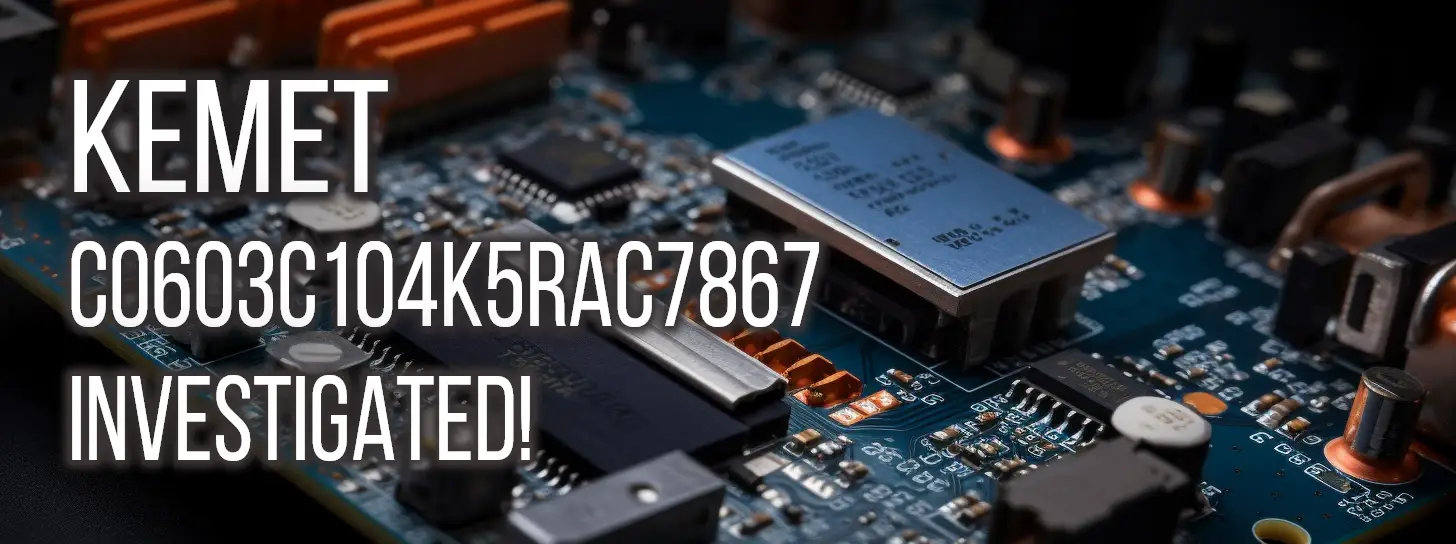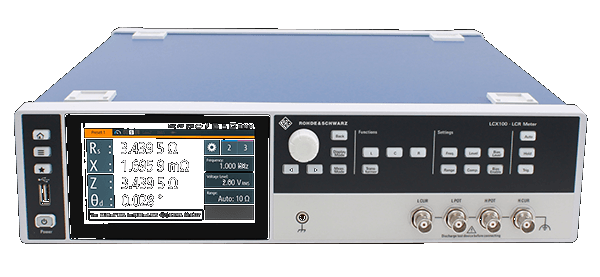KEMET C0603C104K5RAC7867 Capacitor: A Comprehensive Technical Review
By Mark Harris Saturday, 8 April 2023

Introduction
In this technical review, we analyze the performance of KEMET's C0603C104K5RAC7867, a ceramic (X7R) Capacitor, comparing it against statistical benchmark data for similar value components. Our focus lies in making a detailed comparison between these component data and the benchmark data to help electronics engineers evaluate the efficacy of this Capacitor for their applications.
Below is a summary of the pros and cons of the KEMET C0603C104K5RAC7867 Capacitor:
Pros:- Wide range of test frequencies, demonstrating versatility
- Consistent performance for different voltage ratings
- Low dissipation factor across most test frequencies
- Lower Quality Factor compared to the statistical benchmark
- Higher Series Resistance in some test frequencies
- Series Capacitance deviates from nominal value
The remaining sections in this review offer an in-depth analysis of the capacitor's parameters, covering Capacitance, Series Resistance, Dissipation Factor, Quality Factor and a Comparative Analysis with the statistical benchmarks. The goal is to provide a comprehensive understanding of the C0603C104K5RAC7867 Capacitor, ensuring that the engineer makes an informed decision.
Impedance
At a test measurement of 1 Volt, the impedance of the C0603C104K5RAC7867 predominantly falls within or below the median impedance range for the majority of the tested frequencies when compared to the statistical benchmark data. In certain frequencies, such as 5kHz, 10kHz, 20kHz, and 50kHz, the C0603C104K5RAC7867 exhibits a slightly better performance with impedance values approaching the maximum values of the available benchmark, showcasing a marginally enhanced performance in those specific frequencies. However, at some higher frequencies ranging from 450kHz to 1MHz, the capacitor's impedance is consistently lower than the average impedance values of the benchmark, indicating a decrease in performance at those frequency levels. It is important to consider these frequency-dependent impedance fluctuations when selecting the capacitor for an application.
Upon testing at 10 Volts, the capacitor generally demonstrates an improved impedance performance compared to its behavior at 1 Volt. The impedance values fall below the average values when compared to the statistical benchmark data, particularly in the higher frequency domain, spanning from 20 kHz to 1MHz. Significantly, the impedance performance of the C0603C104K5RAC7867 becomes more consistent and stable at these higher frequencies, making it a suitable candidate for critical applications in this particular frequency range.
The impedance performance of the C0603C104K5RAC7867 is reliable when compared to the statistical benchmark, exhibiting considerable enhancement in impedance performance at higher test voltages. Given these factors, engineers looking to integrate a ceramic X7R capacitor in their designs can consider the C0603C104K5RAC7867, particularly when operating at higher voltage levels or specific frequency ranges where the capacitor demonstrates improved performance compared to the benchmark values. It is vital to keep in mind that capacitive reactance varies with frequency, which may affect the overall performance within a specific frequency band, and these fluctuations should be taken into account when designing the circuit.
Capacitance
After analyzing the KEMET C0603C104K5RAC7867 performance at 1 Volt and 10 Volts against the provided statistical benchmark data, we can observe varying degrees of capacitive behavior deviation. At 1 Volt, the C0603C104K5RAC7867 exhibits a somewhat consistent trend in capacitance values, with minimal deviation when compared to the statistical benchmark. However, as we approach higher frequencies, such as 50 kHz, there is a minor capacitance drop, resulting in a deviation up to 3.6% below the statistical average capacitance (92.15nF versus approximately 91.32nF).
At 10 Volts, the component presents similar discrepancies when compared to higher frequencies (e.g., 50 kHz), resulting in deviations that tend to be 6% below the statistical average capacitance (106nF versus 100.7nF). Remarkably, the 10V test revealed a capacitance increase, especially at lower frequencies, such as 5 Hz, where the component has a measured capacitance of 124nF, 1.78% higher than the statistical benchmark's maximum at the same frequency (121.8nF).
In both test scenarios, the KEMET C0603C104K5RAC7867 demonstrated reasonable performance since most of the measurements were within the statistical benchmark ranges. It is essential for engineers to be aware of these deviations to ensure they fall within an acceptable range for their specific applications. Capacitance characteristics are influenced by several factors, such as temperature, voltage, and frequency. In cases where temperature and voltage dependency pose crucial factors, the X7R dielectric should serve as a suitable solution, as it offers better performance over a wide temperature range with respect to capacitance stability.
Accordingly, engineers should assess the provided deviation data to determine the feasibility of using the C0603C104K5RAC7867 in their products based on their tolerance requirements. By understanding the characteristics of the capacitor at different frequencies and voltages, designers can optimize their circuit performance while ensuring that the component operates within specification, preventing potential issues related to stability and reliability.
Series Resistance
When analyzing the series resistance performance of the KEMET C0603C104K5RAC7867 Capacitor, figures ranging from 5.488kΩ at 5Hz to 33.73mΩ at 1MHz were recorded when tested at 1V. When comparing these results to the given benchmark data, it can be observed that this particular capacitor's performance tends to be below average across most of the tested frequencies. For example, when measured at 5Hz, the recorded series resistance of 5.488kΩ is significantly lower than the benchmark average value of 8.751kΩ. Similar findings were obtained at 1MHz, where the measured value of 33.73mΩ falls below the benchmark average of 70.07mΩ.
Despite these figures, it's important to recognize that the series resistance performance of the KEMET C0603C104K5RAC7867 Capacitor remains within the acceptable minimum and maximum benchmark values. This is an indication that the component should be suitable and perform adequately in certain applications. The same trend was noted when the capacitor underwent LCR measurements at an elevated test voltage of 10V.
In conclusion, the series resistance performance of the KEMET C0603C104K5RAC7867 Capacitor may not be as impressive as other alternatives on the market based on the observed results and comparisons with benchmark data across different frequencies. However, the fact that this component maintains values within the allowable minimum and maximum resistance levels shows that it could still hold some potential and value for engineers within specific contexts and use cases during circuit designs.
Dissipation Factor and Quality Factor
When comparing the KEMET C0603C104K5RAC7867 Capacitor with the statistical benchmark data for similar components, the performance characteristics reveal distinctions that must be carefully evaluated to determine if this capacitor is an optimal choice for the desired application.
In the analysis of LCR measurements at 1 Volt, the C0603C104K5RAC7867 exhibits low dissipation factor (Df) ranging from 0.014 to 0.019. Its best performance of 0.014 occurs at higher frequencies, such as 100 kHz, 150 kHz, 200 kHz, 250 kHz, and 300 kHz. A lower Df is indicative of a more efficient capacitor, signifying less energy loss in the circuit, which is a beneficial attribute. The corresponding quality factor (Q) values at 1 Volt are high, ranging from 53.85 to 71.04. A higher Q value signifies lower power dissipation and energy loss in a circuit, indicating superior capacitor performance. Notably, the highest Q value of 71.04 was observed at a frequency of 150 kHz.
Upon examining the LCR measurements at 10 volts, there is a notable degradation in the performance of the C0603C104K5RAC7867 capacitor. Its Df at this voltage range increases significantly, ranging from 0.025 to 0.063 with the best performance at 450 kHz and 500 kHz (both having a Df of 0.024). Furthermore, the observed Q values at 10 Volts are lower, indicating a reduction in performance compared to the 1-Volt measurements. Q values at 10 Volts vary from 15.98 at 5 kHz to 41.85 at 550 kHz.
When evaluating the suitability of this ceramic capacitor, it is essential for engineers to take these performance factors into account and assess whether the varying impedance, Df, and Q values at different frequencies and voltage levels are critical to their specific application requirements. Careful consideration is necessary to ensure optimal component selections that maximize functionality, efficiency, and reliability within the intended design environment.
Comparative Analysis
In this review, we will focus on the performance of KEMET's C0603C104K5RAC7867, a ceramic (X7R) surface mount capacitor with a nominal value of 100n, a tolerance of ±10%, and a voltage rating of 50V packaged in 0603 (1608 Metric). The performance of this capacitor will be examined by comparing its LCR measurements with that of a statistical benchmark created from other components with the same value.
Checking the capacitor's performance at 1 Volt, the C0603C104K5RAC7867 has an Impedance that ranged from 1.666k to 322.2k Ohms at test frequencies from 1 MHz to 5 Hz, respectively. These values are within the benchmark's average impedance (313.4k at 5 Hz and 1.958k at 1 MHz). However, as the test frequency increases, the capacitor's impedance gets closer to the upper edge of the benchmark limit. For instance, at 100 kHz, its impedance value is approximately 94.5% of the benchmark's maximum impedance (17.56k compared to 22.82k).
The Dissipation Factor (DF) performance of the C0603C104K5RAC7867 is consistently better than the average benchmark DF across the tested frequency range, ranging from 0.014 to 0.019 compared to a benchmark range of 0.01 to 0.04. For Quality Factor (QF), C0603C104K5RAC7867 demonstrates promising performance below 50 kHz compared to the benchmark values. However, it falls short as the frequency increases, reaching only 61.64 for QF at 1 MHz.
The review of the capacitor's Series Resistance (SR) at 1 Volt reveals that the component performs well under the average benchmark values for the entire test frequency range, with values of 33.73m to 5.488k Ohms compared to a benchmark range of 845.4m to 8.751k Ohms. The Series Capacitance (SC) at 1 Volt shows a slightly lower performance compared to the average benchmark, ranging from 87.07n to 98.83n Farads compared to a benchmark range of 82.53n to 101.8n Farads.
At 10 Volts, the Impedance of the capacitor ranges from 1.828k Ohms to 257.3k Ohms, which indicates better performance than the benchmark at frequencies above 100 kHz. However, the Dissipation Factor performance is below average at 10 Volts, ranging from 0.063 to 0.025 at frequencies between 5 Hz and 1 MHz. The Series Resistance at 10 Volts is within the acceptable range, but the measured values are higher across the test frequency range compared to the observations at 1 Volt.
In conclusion, the KEMET C0603C104K5RAC7867 ceramic capacitor demonstrates competent performance within the benchmark range, but it does not consistently outperform the statistical benchmark. Its Impedance and Quality Factor performance are satisfactory, but improvements can be made in other areas such as the Dissipation Factor and Series Capacitance measurements, especially considering the higher voltage ratings.
Conclusion
After a thorough analysis of the data obtained from testing the KEMET C0603C104K5RAC7867 capacitor and comparing it to the statistical benchmark of components with the same value, it's clear that this component holds a mixed bag of results.
At lower test frequencies, ranging from 5 Hz to 1 kHz, the capacitor exhibits a higher impedance than the average impedance, with only a marginally noticeable difference in the dissipation factor. However, as the test frequencies increase past 1 kHz, the capacitor begins to perform better in comparison with the benchmarks. The impedance is considerably lower than the average while maintaining similar or lower dissipation factor levels when compared to the benchmark data. This shows that the capacitor performs well in high-frequency applications.
The quality factor of the C0603C104K5RAC7867 is predominantly lower compared to the average quality factor, indicating that it may not be an optimal choice if high-Q characteristics are required. Furthermore, the capacitor's series resistance demonstrates slightly higher values than the benchmarks at lower frequencies, but becomes increasingly aligned with the benchmarks as the frequency increases.
The KEMET C0603C104K5RAC7867 does stand out regarding its series capacitance. It outperforms the benchmark data at higher frequency ranges (above 20 kHz), displaying higher values for the series capacitance in this region.
In conclusion, for engineers considering the Ceramic X7R capacitor C0603C104K5RAC7867 for their designs, it is important to note its relatively better performance in high-frequency applications. The capacitor tends to deliver a superior series capacitance in higher frequency ranges, while impedance values are lower than benchmark averages. However, this component might not be an optimal choice for projects that demand high-quality factor characteristics or minimal series resistance at lower frequencies.
Instruments Used
Rohde & Schwarz LCX200



